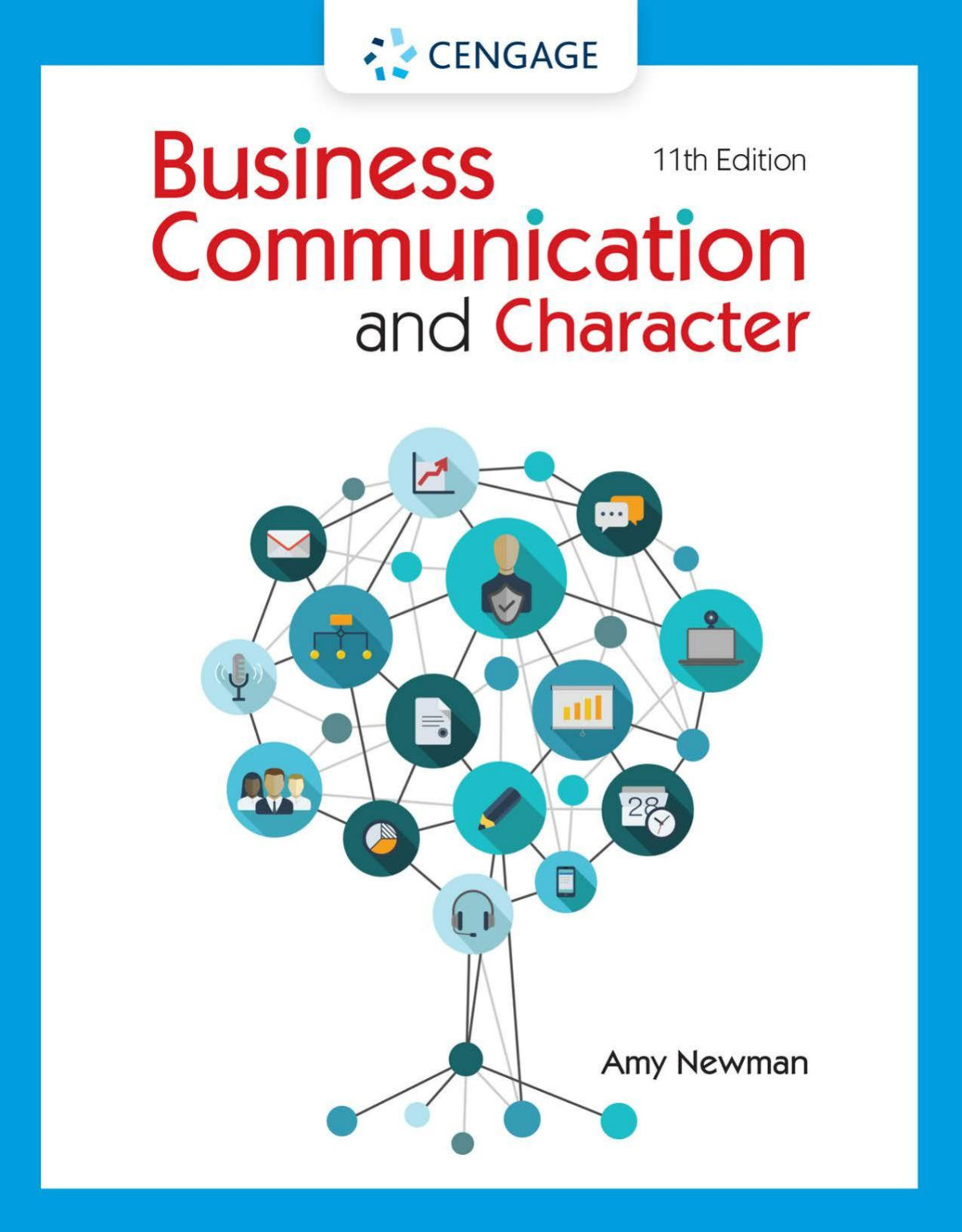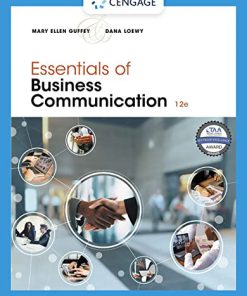Business Communication and Character by Amy Newman 9780357718131 0357718135
$50.00 Original price was: $50.00.$25.00Current price is: $25.00.
Business Communication and Character Amy Newman – Ebook PDF Instant Download/Delivery, ISBN: 9780357718131, 0357718135

Product details:
- ISBN 10:0357718135
- ISBN 13:9780357718131
- Author: Amy Newman
Business Communication and Character
Table contents:
Part 1. Communicating Character and Building Business Relationships
Chapter 1. Introduction to Business Communication and Character
1-1. Business Communication and Character
1-1a. The Value of Proficient Communication Skills
1-1b. Demonstrating Character Through Communication
1-2. Components of Communication
1-2a. How Communication Happens
1-2b. The CAM Communication Model
1-3. Character Check
1-3a. Self-Awareness and Emotional Intelligence
1-3b. Communication Need and Purpose
1-3c. Potential Legal Consequences of Communication
1-3d. Ethics and Communication
1-4. Audience Analysis
1-4a. Communication Context
1-4b. Communication Directions
1-4c. Communication Barriers
1-5. Message and Medium
1-5a. Traditional Communication Channels
1-5b. Technology-Based Communication Media
1-5c. Choosing Communication Media
1-5d. Multicommunicating
1-6. Chapter Closing
The CAM Model
CAM in Action. Decide Whether Graphics Are Ethical
CAM in Practice. Write a Company Response
Reflecting on Your Communication and Character Development
Developing Your Business Communication Skills
Chapter Summary
Chapter 2. Team and Interpersonal Communication
2-1. Work Team Communication
2-1a. Team Formation
2-1b. Types of Team Communication
2-1c. Accountability
2-1d. Giving
2-1e. The Ethical Dimension of Team Communication
2-2. Virtual Team Communication
2-2a. Developing Social Presence
2-2b. Setting Goals and Norms
2-2c. Choosing a Collaboration Platform
2-2d. Calling and Messaging
2-3. Collaborative Writing
2-3a. Applying Strategies for Team Writing
2-3b. Commenting on Team Writing
2-4. Business Meetings
2-4a. Determining the Meeting Format
2-4b. Planning the Meeting
2-4c. Facilitating the Meeting
2-4d. Participating in the Meeting
2-4e. Following Up After the Meeting
2-5. Nonverbal Communication
2-5a. Facial Expressions and Gestures
2-5b. Body Movement
2-5c. Physical Appearance
2-5d. Voice Qualities
2-5e. Touch
2-6. Listening
2-6a. Empathy, Sympathy, and Compassion
2-6b. The Value of Listening
2-6c. Keys to Better Listening
2-7. Chapter Closing
CAM in Action. Decide Whether to Remove “Black Lives Matter” Messages
CAM in Practice. Plan a Meeting with Basketball Players
Reflecting on Your Communication and Character Development
Developing Your Business Communication Skills
Chapter Summary
Chapter 3. Communicating Across Differences
3-1. Shifting Your Mindset
3-1a. Acknowledging Your Own Cultural Identities and Views
3-1b. Learning When We’re Uncomfortable
3-1c. Reducing Blanket Judgments of Others
3-2. Managing Through Conflict
3-2a. Assessing Types of Conflict
3-2b. Deciding Whether to Engage in Conflict
3-2c. Engaging Productively
3-3. Engaging in Difficult Conversations
3-3a. Preparing for a Difficult Conversation
3-3b. Encouraging a Dialogue
3-3c. Giving and Receiving Constructive Feedback
3-4. Communicating to Improve Inclusivity and Belonging
3-4a. Understanding Diversity, Inclusion, and Belonging
3-4b. Bringing Your Whole Self to Work
3-4c. Using Inclusive Language
3-4d. Offending and Taking Offense
3-5. Adapting to International Cultural Differences
3-5a. Understanding Cultural Differences
3-5b. Adapting to Different Cultures
3-5c. Communicating Across Languages
3-6. Chapter Closing
CAM in Action. Decide Whether to Engage in Conflict about Extravagant Wedding Plans
CAM in Practice. Prepare for a Difficult Conversation about the Extravagant Plans
Reflecting on Your Communication and Character Development
Developing Your Business Communication Skills
Chapter Summary
Part 2. Developing Your Business Writing Skills
Chapter 4. Writing and Designing
4-1. Business Writing Process Overview
4-2. Audience Analysis
4-2a. Understanding Audience Analysis
4-2b. Applying the Five Questions
4-2c. Adjusting a Message for a Manager
4-3. Planning
4-3a. Purpose
4-3b. Content
4-3c. Organization
4-4. Drafting
4-4a. Letting Go
4-4b. Writing Emails, Memos, and Letters
4-4c. Writing for the Web
4-5. Designing
4-5a. Design Principles
4-5b. Document Design
4-5c. Web Design
4-6. Revising and Proofreading
4-6a. Revising
4-6b. Proofreading
4-7. Chapter Closing
CAM in Action. Encourage State Farm Web Writers to Change the Text
CAM in Practice. Revise State Farm Website
Reflecting On Your Communication and Character Development
Developing Your Business Communication Skills
Chapter Summary
Chapter 5. Improving Your Writing Style
5-1. Developing Writing Style
5-1a. Style and Character
5-1b. Principles of Style
5-2. Choosing the Best Words
5-2a. Write Clearly
5-2b. Write Concisely
5-3. Writing Effective Sentences
5-3a. Use a Variety of Sentence Types
5-3b. Use Active and Passive Voice Appropriately
5-3c. Use Parallel Structure
5-4. Developing Logical Paragraphs
5-4a. Keep Paragraphs Unified and Coherent
5-4b. Control Paragraph Length
5-5. Creating an Appropriate Tone
5-5a. Find Your Own Professional, Conversational Voice
5-5b. Write Confidently
5-5c. Use a Courteous and Sincere Tone
5-5d. Use Appropriate Emphasis and Subordination
5-5e. Use Positive Language
5-5f. Stress the “You” Attitude
5-6. Chapter Closing
CAM in Action. Write a Friendly “Cease-and-Desist” Letter
CAM in Practice. Responding to a “Cease-and Desist” Letter
Reflecting On Your Communication and Character Development
Developing Your Business Communication Skills
Chapter Summary
Part 3. Crafting Written Messages
Chapter 6. Neutral and Positive Messages
6-1. Creating a Positive Work Environment
6-1a. Appreciation at Work
6-1b. Types of Positive and Neutral Messages
6-2. Writing Neutral Messages
6-2a. Start with the Main Point
6-2b. Provide an Explanation and Details
6-2c. End on a Positive Note
6-2d. Respond to a Neutral Message
6-3. Writing Goodwill Messages
6-3a. Guidelines for Goodwill Messages
6-3b. Recognition Notes
6-3c. Congratulatory Notes
6-3d. Thank-You Notes
6-3e. Sympathy Notes
6-4. Addressing Social Media Comments
6-4a. Deciding Whether to Respond
6-4b. Responding to Positive Reviews
6-5. Engaging Customers and Employees on Social Media
6-5a. Engaging Customers Online
6-5b. Engaging Employees Online
6-6. Chapter Closing
CAM in Action. Decide How to Convey the “Pay It Forward” News
CAM in Practice. Write an Opinion Letter
Reflecting on Your Communication and Character Development
Developing Your Business Communication Skills
Chapter Summary
Chapter 7. Persuasive Messages
7-1. Planning Persuasive Messages
7-1a. Persuading Ethically
7-1b. Understanding Resistance
7-1c. Analyzing Your Audience
7-1d. Tailoring to Your Audience
7-2. Applying Persuasive Strategies
7-2a. Start with “Why”
7-2b. Demonstrate Credibility
7-2c. Appeal to Prosocial Emotions
7-2d. Develop Logical Arguments
7-2e. Apply Principles of Influence
7-3. Writing Persuasive Messages
7-3a. Internal Persuasive Messages
7-3b. External Persuasive Messages
7-4. Writing and Responding to Negative Feedback
7-4a. Repairing Company Image
7-4b. Writing Complaints and Online Reviews
7-4c. Responding to Negative Feedback
7-5. Chapter Closing
CAM in Action. Persuade the Company President to Start an Employee Assistance Fund
CAM in Practice. Persuade Employees to Donate
Reflecting on Your Communication and Character Development
Developing Your Business Communication Skills
Chapter Summary
Chapter 8. Bad-News Messages
8-1. Planning Bad-News Messages
8-1a. Character and Context Check
8-1b. Audience Analysis
8-1c. Message and Media Choice
8-2. Writing Components of Bad-News Messages
8-2a. Organizing the Message
8-2b. Explaining the Decision
8-2c. Giving the Bad News
8-2d. Closing the Message
8-3. Writing Bad-News Replies
8-3a. Rejecting an Idea
8-3b. Refusing a Favor
8-3c. Refusing a Customer Request
8-4. Announcing Bad News
8-4a. Bad News About Normal Operations
8-4b. Bad News About the Organization
8-4c. Bad News About Jobs
8-5. Giving and Receiving Constructive Performance Feedback
8-5a. Giving Constructive Feedback
8-5b. Receiving Constructive Feedback
8-6. Chapter Closing
CAM in Action. Cancel a Planned Wedding
CAM in Practice. Announce a Property Closing
Reflecting On Your Communication and Character Development
Developing Your Business Communication Skills
Chapter Summary
Part 4. Preparing Data and Writing Reports
Chapter 9. Managing and Visualizing Data
9-1. Identifying Types and Sources of Data
9-1a. Identifying Types of Data
9-1b. Searching for Relevant Sources
9-1c. Avoiding Bias
9-2. Evaluating Sources of Information
9-2a. Evaluating Internet Resources
9-2b. Evaluating Research Studies
9-3. Collecting Data Through Surveys
9-3a. Using Surveys for Data Collection
9-3b. Choosing Types of Survey Questions
9-3c. Writing Survey Questions
9-3d. Writing a Survey Email
9-4. Visualizing Data
9-4a. Creating Tables
9-4b. Designing Simple, Clear Charts
9-4c. Choosing an Appropriate Chart Type
9-4d. Creating Infographics
9-5. Analyzing and Presenting Data
9-5a. Making Sense of the Data
9-5b. Avoiding Misleading Data Presentations
9-6. Chapter Closing
CAM in Action. Provide Feedback on the Softbank Chart
CAM in Practice. Prepare a Chart for the Softbank CEO to Present
Reflecting on Your Communication and Character Development
Developing Your Business Communication Skills
Chapter Summary
Chapter 10. Writing Reports
10-1. Planning the Report
10-1a. Distinguishing Types of Reports
10-1b. Selecting a Report Format
10-1c. Organizing the Report
10-2. Drafting the Report
10-2a. Creating Report Sections
10-2b. Drafting the Body
10-2c. Drafting Supplementary Sections
10-3. Developing an Effective Writing Style
10-3a. Tone
10-3b. Pronouns
10-3c. Verb Tense
10-3d. Emphasis and Subordination
10-3e. Coherence
10-4. Documenting Your Sources
10-4a. Why We Document Sources
10-4b. What Must Be Documented
10-4c. How to Document Sources
10-4d. How to Avoid Distortion by Omission
10-5. Designing, Formatting, and Refining the Report
10-5a. Designing and Formatting Text-Based Reports
10-5b. Designing and Formatting Slide Decks
10-5c. Refining Your Report
10-6. Chapter Closing
CAM in Action. Decline Work to Market Opioids
CAM in Practice. Create a Deck About the Opioid Crisis
Reflecting On Your Communication and Character Development
Developing Your Business Communication Skills
Chapter Summary
Part 5. Developing and Delivering Presentations and Visuals
Chapter 11. Developing Presentations and Visuals
11-1. Adapting a Presentation
11-1a. Purpose
11-1b. Audience Analysis
11-2. Organizing a Presentation
11-2a. The Story
11-2b. The Opening
11-2c. The Body
11-2d. The Ending
11-3. Designing Presentation Slides
11-3a. Choosing Visual Support
11-3b. Creating an Attractive, Appropriate Design
11-3c. Replacing Text with Meaningful Graphics
11-4. Reinforcing Main Points on Slides
11-4a. Surfacing Your Main Points
11-4b. Making Your Presentation Easy to Follow
11-4c. Writing Simply and Clearly
11-5. Developing Additional Visuals
11-5a. Using Video
11-5b. Creating Handouts
11-5c. Choosing Other Visuals
11-6. Chapter Closing
CAM in Action. Prepare an In-Person Presentation for a Monthly Report About Athleta
CAM in Practice. Prepare an Online Presentation to Athleta Store Managers
Reflecting on Your Communication and Character Development
Developing Your Business Communication Skills
Chapter Summary
Chapter 12. Delivering Presentations
12-1. Preparing Yourself to Present
12-1a. Projecting Confidence and Demonstrating Presence
12-1b. Choosing a Delivery Style
12-2. Delivering In-Person Presentations
12-2a. Setting the Stage and Ending Strongly
12-2b. Moving Your Body
12-2c. Finding Your Natural Speaking Voice
12-2d. Interacting with Visuals
12-2e. Practicing
12-3. Delivering Online and Team Presentations
12-3a. Delivering Online Presentations
12-3b. Delivering Team Presentations
12-4. Connecting with Specific Audiences
12-4a. Presenting to Challenging Audiences
12-4b. Using Humor in Business Presentations
12-5. Responding to Questions and Feedback
12-5a. Preparing for Questions
12-5b. Deciding Whether to Take Questions Throughout a Presentation
12-5c. Responding to Questions
12-5d. Asking Questions
12-5e. Addressing Comments Online
12-6. Chapter Closing
CAM in Action. Provide Feedback to Wen Muenyi
CAM in Practice. Provide Feedback to Another Shark Tank Presenter
Reflecting on Your Communication and Character Development
Developing Your Business Communication Skills
Chapter Summary
Part 6. Presenting Yourself for Employment
Chapter 13. Writing for the Job Search
13-1. Presenting Your Best Self
13-1a. Being Yourself
13-1b. Identifying Your Strengths
13-1c. Following the Selection Process
13-2. Preparing Your Resume
13-2a. Strategic Decisions about Your Resume
13-2b. Resume Length
13-2c. Resume Format
13-2d. Resume Content
13-2e. Resume Screening Software
13-3. Developing a Professional Online Presence
13-3a. Managing Your Online Reputation
13-3b. Creating a Social Profile
12-3c. Strengthening Your Online Presence
13-4. Writing Cover Letters and Networking Messages
13-4a. Cover Letters
13-4b. Networking Messages
13-5. Chapter Closing
CAM in Action. Decide Whether to Include a Company on My Resume
CAM in Practice. Write a Cover Letter
Reflecting on Your Communication and Character Development
Developing Your Business Communication Skills
Chapter Summary
Chapter 14. Interviewing and Landing the Job
14-1. Preparing for a Job Interview
14-1a. Researching the Organization
14-1b. Practicing Interview Questions
14-1c. Preparing Your Own Questions
14-2. Presenting Yourself During an Interview
14-2a. Making a Good Impression
14-2b. Demonstrating Confidence in Your Qualifications
14-2c. Managing Video and Phone Interviews
14-2d. Responding to Multiple Interviewers
14-3. Following Up After the Interview
14-3a. Assessing Yourself and the Company
14-3b. Sending a Thank-You Note
14-3c. Handling Disappointing Responses
14-4. Managing Job Offers
14-4a. Negotiating a Job Offer
14-4b. Declining a Job Offer
14-4c. Turning Down a Job Candidate
14-5. Demonstrating Professionalism at Work
14-5a. Scanning the Environment
14-5b. Meeting and Greeting, Sharing Meals, and Exchanging Gifts
14-5c. Socializing Outside of Work and Connecting on Social Media
14-6. Chapter Closing
People also search:business communication and character amy newman
business communication and character by amy newman
amy newman business communication and character 11th edition
business communication amy newman pdf
amy newman business communication
You may also like…
Business & Economics - Others
Business & Economics - Management & Leadership
Business and Professional Communication Plans Processes and Performance 6th Edition James R. Disanza
Technique - Communication
Excellence in Business Communication 12th Edition by John Thill 9780134319056
Medicine - Dentistry
Business & Economics - Job Hunting & Careers
Politics & Philosophy - Government & Politics
Relationships & Lifestyle - The Art of Communication
Essentials of Business Communication, 12th Edition Mary Ellen Guffey
Technique - Communication
Communication for Business and the Professions : Strategies and Skills, Seventh Edition Judith Dwyer
Technique - Communication
The Business Communication Handbook, Eleventh Edition Judith Dwyer












